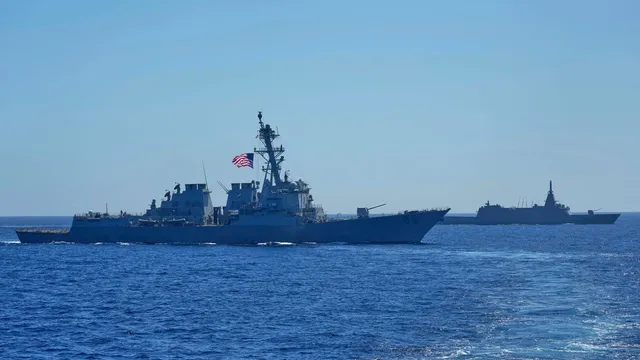
US, Japan, and Philippines conduct joint naval drills in contested waters
2025-03-31 22:55- The U.S., Japan, and the Philippines conducted joint naval drills to enhance crisis readiness and cooperation in the South China Sea.
- During the exercises, a Chinese ship monitored the situation, highlighting ongoing territorial disputes in the area.
- These actions signify the strengthening of defense ties amongst the three nations amidst regional security concerns.
Express your sentiment!
Insights
In March 2025, in the waters of the South China Sea, the United States, Japan, and the Philippines conducted joint naval exercises amid increasing tensions with China. These maneuvers aimed at enhancing crisis readiness and improving coordination among the allied forces. As tensions escalated, a Chinese military ship monitored the exercises from a distance, prompting Philippine naval forces to issue warnings to prevent the vessel from encroaching closer to their territory. The drills included the participation of various naval assets, demonstrating a show of force and solidarity among the three nations. During the same month, U.S. Defense Secretary Pete Hegseth announced an expansion of military capabilities in the Philippines. This initiative included the deployment of advanced weaponry such as the Navy Marine Expeditionary Ship Interdiction System, as well as improved cooperation in areas like defense industrial collaboration and cyber defense. Hegseth's visit marked an effort to strengthen U.S.-Philippines ties and counter China's assertiveness in the region. The Philippines has been facing prolonged territorial disputes with China, particularly concerning the Scarborough Shoal, which has seen heightened confrontations in recent years. As part of a broader strategic framework, the U.S. and the Philippines agreed to prioritize industrial cooperation in defense, cybersecurity, and logistics support. This plan aims to bolster the Philippines' capabilities in developing its defense systems and enhancing its regional defense roles. The Pentagon emphasized the urgency of re-establishing deterrence in the Indo-Pacific area, addressing what Hegseth described as a period of
Contexts
The disputes in the South China Sea have deep historical roots and are influenced by a complex interplay of regional ambitions, geopolitical interests, and colonial legacies. The South China Sea is vital both economically and strategically, as it is a major trade route that facilitates a significant portion of global commerce. The tensions largely stem from overlapping territorial claims among several nations, including China, Vietnam, the Philippines, Malaysia, Brunei, and Taiwan, each asserting rights based on historical, legal, and geopolitical narratives. This maritime region is rich in resources, such as fishing grounds and potential underwater oil and gas deposits, making control over these areas fiercely contested. Historical claims can be traced back centuries, with various empires and states using different methods to assert sovereignty over the land features within the sea. However, the modern configuration of claims began to take shape post-World War II when various countries sought to assert their rights over islands and waters as a means to bolster national pride and security. The establishment of the People's Republic of China in 1949 marked a significant turning point, as the Chinese government claimed extensive maritime rights, often referred to as the 'nine-dash line', which has been a source of contention, particularly with its neighbors. International law, particularly the United Nations Convention on the Law of the Sea (UNCLOS), has sought to provide a legal framework for resolving these conflicts, yet its application has been met with selective adherence, further complicating the dispute. The geopolitical landscape of the South China Sea is further complicated by the involvement of external powers, primarily the United States, which maintains a presence in the region under the auspices of protecting freedom of navigation and supporting allied nations in the face of Chinese expansionism. The U.S. has conducted freedom of navigation operations and forged strategic partnerships with regional allies to counterbalance China's assertive claims. This involvement reflects broader global power dynamics and highlights the importance of the South China Sea not merely as a regional issue, but one that has implications for international security and trade. Recent developments have seen an escalation in confrontational tactics, particularly with China's military buildup on artificial islands and increased naval activity. This militarization has alarmed neighboring countries and raised concerns within the international community over the stability of the region. Diplomatic efforts to mitigate tensions, such as ASEAN's role and bilateral negotiations, have yielded limited results, often stalled by differing national interests and the complexity of layered historical grievances. The South China Sea remains a flashpoint where historical context, national interests, and global politics converge, and addressing these disputes requires a nuanced understanding of the intricate historical narratives and the ongoing geopolitical chess game.